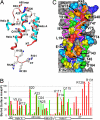Structure and mechanism of IFN-gamma antagonism by an orthopoxvirus IFN-gamma-binding protein
- PMID: 18252829
- PMCID: PMC2542861
- DOI: 10.1073/pnas.0705753105
Structure and mechanism of IFN-gamma antagonism by an orthopoxvirus IFN-gamma-binding protein
Abstract
Ectromelia virus (ECTV) encodes an IFN-gamma-binding protein (IFN-gammaBP(ECTV)) that disrupts IFN-gamma signaling and its ability to induce an antiviral state within cells. IFN-gammaBP(ECTV) is an important virulence factor that is highly conserved (>90%) in all orthopoxviruses, including variola virus, the causative agent of smallpox. The 2.2-A crystal structure of the IFN-gammaBP(ECTV)/IFN-gamma complex reveals IFN-gammaBP(ECTV) consists of an IFN-gammaR1 ligand-binding domain and a 57-aa helix-turn-helix (HTH) motif that is structurally related to the transcription factor TFIIA. The HTH motif forms a tetramerization domain that results in an IFN-gammaBP(ECTV)/IFN-gamma complex containing four IFN-gammaBP(ECTV) chains and two IFN-gamma dimers. The structure, combined with biochemical and cell-based assays, demonstrates that IFN-gammaBP(ECTV) tetramers are required for efficient IFN-gamma antagonism.
Conflict of interest statement
The authors declare no conflict of interest.
Figures





References
-
- Esteban DJ, Buller RM. Ectromelia virus: The causative agent of mousepox. J Gen Virol. 2005;86:2645–2659. - PubMed
-
- Seet BT, et al. Poxviruses and immune evasion. Annu Rev Immunol. 2003;21:377–423. - PubMed
-
- Alcami A. Viral mimicry of cytokines, chemokines and their receptors. Nat Rev Immunol. 2003;3:36–50. - PubMed
Publication types
MeSH terms
Substances
Associated data
- Actions
- Actions
Grants and funding
LinkOut - more resources
Full Text Sources
Other Literature Sources
Molecular Biology Databases

